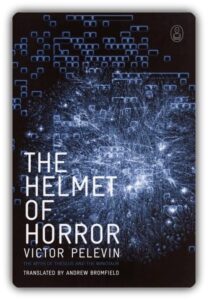What’s the difference between a very long online discussion and a labyrinth? What if the thread is started by someone called Ariadne? “I shall construct a labyrinth in which I can lose myself, together with anyone who tries to find me — who said this and about what?” (p. 1) What if the participants all say they are each in a single room with minimal furnishings — these include a screen and a keyboard, of course — and a door that opens, for most of them, onto some kind of corridor?
The Helmet of Horror builds the twisty, turning, unthreaded conversation out to the length of a short novel in which the participants try to figure out their situations, try to meet up, and talk about what, if anything, it all means. The book was originally published in 2006, a time when fewer people had experience with long-running conversations of this sort, and far fewer in Pelevin’s native Russia. Reading it then, especially for people who were not early adopters of online life, would have seemed like encountering persons from a different world. Even today the book is a good representation of the idiosyncrasies of long online conversations. There’s topic drift, people pop in and out, some try to derail the discussion while others vent their annoyance, some make deeper connections and some play it all for laughs.
The cast of The Helmet of Horror includes Organizm(-: (complete with emoji every time), Romeo-y-Cohiba (whose cigar is not just a cigar) and Nutscracker at the start. Soon after the first three have described their similar situations with the single cell, Monstradamus shows up and asks to join, swiftly followed by the return of Ariadne, who says she fell asleep after starting the thread. In due course IsoldA turns up; her first posting explains to the guys something about manga and tentacle porn. Fortunately, Pelevin leaves a lot unsaid.
Ariadne relates some of the dreams she had after she set up the thread. They included visions of an ancient city that was very much like a labyrinth and seemingly uninhabited except for herself and two dwarves. Eventually she catches up to them, and as they talk one of them
said the master he served was the creator of everything I saw around me, and a great many other things too. The way I understood it, this master of his was not a man. Or not just a man. His name was Asterisk. … The way the dwarf explained it, Asterisk is some boundlessly and infinitely powerful being. I asked whether he didn’t mean God, and he said that God was merely Asterisk’s errand boy. I asked how that was possible. The dwarf told me not even to try to understand. He said it was a great mystery, and repeated this several times. I asked him what was the correct name to use for someone who is mightier than God. Any name you like, the dwarf replied — the word “Asterisk,” or an other that can be spoken — they’re no more than loose dust covers, they make no difference at all. That was what he said, honestly … (pp. 22–23)
True to online behavior, one of the chatters chimes in with “What absolute gibberish.”
The rest of the book continues the conversation as these characters, and others such as UGLI666 and Sartrik who join later, try to figure out their situation, which may or not be the situation of life itself. There is also a great deal of discussion about whether their labyrinth has a Minotaur, and if so what it might be. Is it Asterisk, and the Minotaur is not a prisoner of the maze but its maker? Or perhaps both maker and prisoner? Questions arise about the Minotaur’s head as well, since they are reluctant to believe in the literal grafting of a bull’s head onto a man’s body. Some of Ariadne’s later dreams feature a helmet — the one that gives the book its title — that is like a virtual reality device that projects the wearer into the labyrinth. Maybe they are all wearing helmets that they cannot take off? Would that make them Minotaurs?
There are also suggestions that the helmet, as a tool of Asterisk’s, continuously creates reality, that its curves connect inside and outside in something like topological perpetual motion, and the membrane in it that separates past from future is actually creating one out of the other. How would they know? Pelevin uses an absolute minimum — reading The Helmet of Horror is like reading a play with no stage directions or scene changes — to create clearly delineated characters who interact believably with each other while experiencing fantastical events and debating philosophical questions. Plus a few dick jokes, because they’re a common feature of younger men talking online.
Pelevin plays with the sense of reality and doesn’t provide answers, but that, and rolling along with the conversation, are the joy of the book. It’s strange and unsettling, it doubles back on itself, and there probably isn’t a way out. Just follow the thread and see what happens.


1 ping
[…] years. The most common pair was Russian to English (The Road, Metro 2033, An Armenian Sketchbook, The Helmet of Horror), and those were disparate in their content: two from the middle of the 20th century by Vasily […]